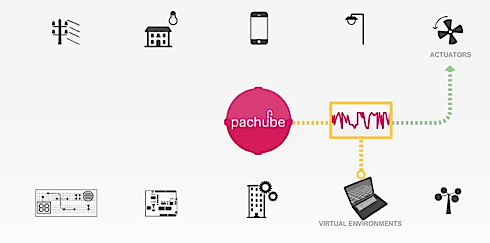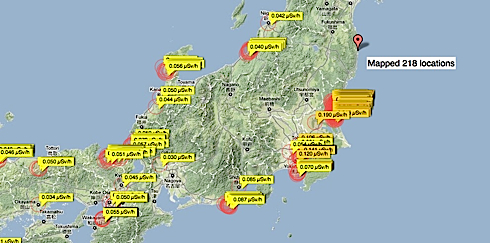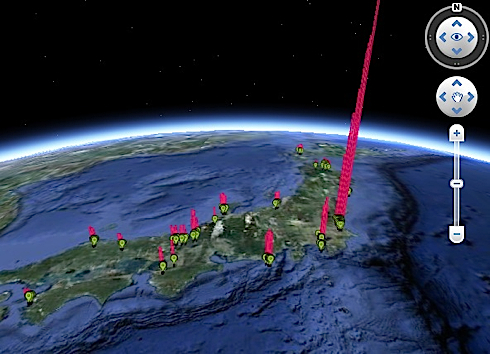Crowdmapping Radiation
When things go wrong, a centralized system, which most nuclear systems are, will be the last to let everyone else know what is going on.
The remedy is crowdsourcing data. A half dozen efforts to crowdmap radiation have bloomed in the past few weeks. The downside to crowdmapping radiation is that radiation is an extremely confusing quality. There are a dozen different units of measurement: rads, rems, roentgens, becquerels, sieverts, grays, coulombs, curies, and several different methods to interpret the signals. Different levels require different methods. It is not like monitoring the weather.
You can purchase or build a digital radiation meter of one type or another for the price of a cheap phone, but not as many amateurs have been monitoring radiation because, thankfully, it has not varied much. Now that there is an immediate reason to track radiation in Japan and East Asian countries, digital radiation sensors are in high demand. One US source for a radiation meter kits (Sparkfun) is out of stock.

But as important as the sensors are, the newest tool is the ease at which sensors can be connected into a network. Chief among the new sensor networks is Pachube. Pachube is the plumbing for the internet of things. Instead of posting your videos on YouTube, you post your data streams on Pachube. Data like temperature, wind, rain, sunshine, pollutants, air particulants, traffic flows, water levels, earthquakes, visibility, and radiation. Anything that can be measured by a sensor. Pachube both stores, displays, and shares environmental data from the network of devices around the world. Anyone can hook a device up, and start streaming data, then sharing it, and then viewing it.

Pachube offers API tutorials, forums, and quickstart info for those interested in joining a sensor network. Their site says:
There are now hundreds of radiation-related feeds from Japan on Pachube, monitoring conditions in realtime and underpinning more than half a dozen incredibly valuable applications built by people around the world. They combine ‘official’ data, ‘unofficial’ official data, and, most importantly to us, realtime networked geiger counter measurements contributed by concerned citizens. Now we’re even seeing some tracking radiation measurements of tap water.
Right now green nerds, anti-nuclear activists, and the worried curious are hooking up as many geiger counters to Pachube as they can. Some folks are shipping digital geiger counters to Japanese friends to have them install them into the sensor network. Initial results can be seen at Japan Geigermap (map below), or Radiation Crowdmap.

The founder of Pachube has constructed his own readout of the radiation sensor streams and plotted them on Google Earth for this very striking display:

Like the Weather Underground, these kind of amateur sensor networks start off kind of rinkydink, a step below the official networks in terms of reliability and integrations. But over time, they acquire a greater density, greater flexibility, greater improvement rate than the official network. These flows of data will be part of the unseen revolution that is what the web becomes next.


